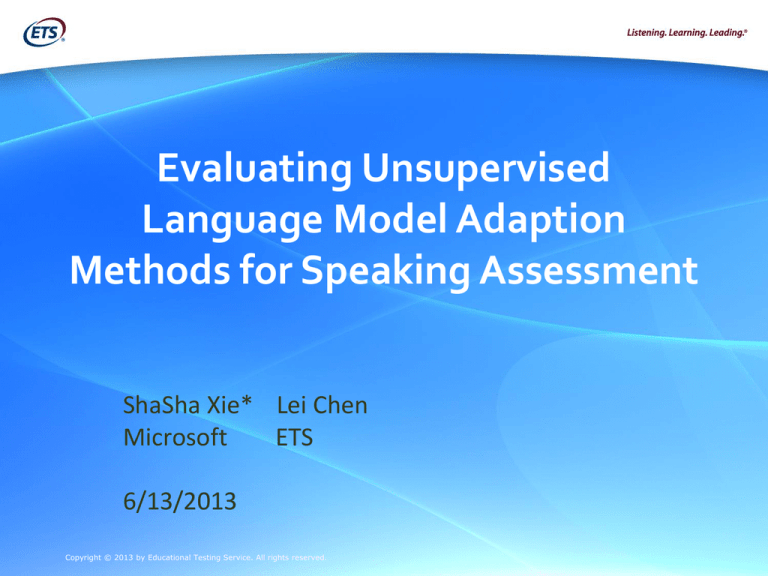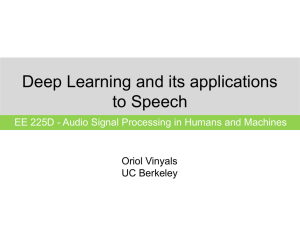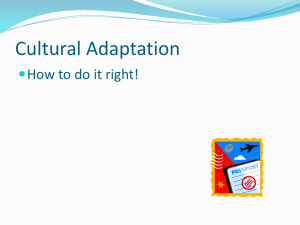
Evaluating Unsupervised
Language Model Adaption
Methods for Speaking Assessment
ShaSha Xie* Lei Chen
Microsoft
ETS
6/13/2013
Copyright © 2013 by Educational Testing Service. All rights reserved.
Model Adaptation, Key to ASR Success
http://youtu.be/5FFRoYhTJQQ
Copyright © 2013 by Educational Testing Service. All rights reserved.
Adaptation
• Modern ASR systems are statistics-rich
– Acoustic model (AM) uses GMM or DNN
– Language model (LM) uses n-gram (n can be large)
• Parameters needed be adjusted to meet new
accent, speakers, environment, content
domains, etc.
• Adaptation is important for achieving
satisfactory recognition accuracy
• Need and prefer using large-sized transcribed
speech files
Copyright © 2013 by Educational Testing Service. All rights reserved.
LM Adaptation Methods
• Supervised LM adaptation
– A large amount of in-domain human annotated
transcripts
• Unsupervised LM adaptation
– No human transcripts
• Using web data to support LM adaptation
– Large-amount, no cost, up-to-date, but noisy
• Semi-supervised LM adaptation
– Minimize the human supervision
– A small amount of human transcripts
Copyright © 2013 by Educational Testing Service. All rights reserved.
Supervised Adaptation
• Given a large amount of
in-domain speech
recordings
• Random sampling
• Obtain the human
transcripts of selected
speech
• Model adaptation
The figure is from Riccardi, Giuseppe, and Dilek Hakkani-Tur. "Active learning:
Theory and applications to automatic speech recognition." Speech and Audio
Processing, IEEE Transactions on 13.4 (2005): 504-511.
Copyright © 2013 by Educational Testing Service. All rights reserved.
Unsupervised Adaptation
• ASR transcripts of indomain data
• Use of ASR transcripts
– All of the transcripts
– Random selection
(Bacchiani and Roark,
2003)
– Selected ASR transcripts
with fewer recognition
errors (Gretter and
Riccardi, 2001)
Copyright © 2013 by Educational Testing Service. All rights reserved.
ASR
Transcripts
Selection
Using Web Data in LM Adaptation
• Use Web data to obtain
in-domain LM training
material
• From ASR tasks,
generate search queries
and use search engines,
i.e., Google or Bing, to
retrieve a large amount
of LM training data
(noisy) in a very fast and
economical way
Copyright © 2013 by Educational Testing Service. All rights reserved.
Searching Web to
collect LM training
data
Semi-supervised LM Adaptation
• Using active learning to
allow human transcribers
to focus on “critical”
utterances
• Run the seed ASR on the
entire un-transcribed
adaptation data set
• Select the utterances that
are poorly recognized for
being transcribed
• This can be an iterative
process
Copyright © 2013 by Educational Testing Service. All rights reserved.
Based on seed ASR
performance to sample
responses for being
transcribed
Related works
•
•
•
•
Michiel Bacchiani, and Brian Roark, “Unsupervised Language
Model Adaptation”, ICASSP, 2003.
Giuseppe Riccardi, and Dilek Hakkani-Tur, “Active Learning:
Theory and Applications to Automatic Speech Recognition”, IEEE
Transactions on Speech and Audio Processing, Vol. 13, No. 4,
2005.
Roberto Gretter, and Giuseppe Riccardi, “On-line Learning of
Language Models with Word Error Probability Distributions”,
ICASSP, 2001.
Ng, T., Ostendorf, M., Hwang, M. Y., Siu, M., Bulyko, I., & Lei, X.
(2005). Web-data augmented language models for Mandarin
conversational speech recognition. Proc. ICASSP (Vol. 1, pp. 89–
593).
Copyright © 2013 by Educational Testing Service. All rights reserved.
Experiment Setup
• Data
– In-domain data: TOEIC ®, work place English
assessment
– Out-of-domain data: TOEFL ®, academic
English assessment
• Seed ASR
– A state-of-the-art HMM ASR trained on TOEFL
data
– WER of 33.0% is found when being tested on
in-domain data
Copyright © 2013 by Educational Testing Service. All rights reserved.
Experiment of Unsupervised
Adaptation
• Data
– Training data for the seed ASR: ~700 hrs (out-ofdomain)
– Adaptation: 1,470 responses, about 24.5 hrs (indomain)
– Testing: 184 responses, about 3 hrs (in-domain)
• Baselines
– No-adaptation
42.8% WER
– Supervised adaptation 34.7% WER
• Selection method
– Average word confidence scores
– Duration-based confidence scores
Copyright © 2013 by Educational Testing Service. All rights reserved.
• Experimental Results
Copyright © 2013 by Educational Testing Service. All rights reserved.
Using Web as a corpus
• A recent trend in NLP & ASR research
fields is to use Web as a corpus
• For example, (Ng et al. 2005) used
Chinese data collected from Web to
do topic adaption, they achieved
28% reduction in LM perplexity and
7% in character recognition.
Copyright © 2013 by Educational Testing Service. All rights reserved.
Using Web data in LM
adaptation
• Create query terms based on test
prompts
• Using search engine to find URLs
• Collect and process the text content in
those URLs
• Apply the collected Web texts on LM
adaptation task
Copyright © 2013 by Educational Testing Service. All rights reserved.
An example
• Prompt
–Do you agree or disagree with the following
statement? Advances in technology have made
the world a better place. Use specific reasons
and examples to support your opinion
• Query
– "advances in technology" made "the
world" "a better place“
Copyright © 2013 by Educational Testing Service. All rights reserved.
An example (continuing)
• Cleaned URLs
– http://answers.yahoo.com/question/index?qid=20090205084424AA0P
rID
– http://thichnhattim.wordpress.com/2011/08/08/why-did-the-worldstop
– http://www.allfreeessays.com/topics/advancement-in-technology/0
– http://www.allfreeessays.com/topics/how-technology-destroy-ourworld/0
– http://www.crcpd.org/national_radiation_protection_week.aspx
– http://www.cyberessays.com/lists/modern-technology-has-madelife-easier-and-safer/page0.html
– http://www.dontread.org
– http://www.english-test.net/forum/ftopic52466.html
– http://www.oppapers.com/subjects/how-wireless-technology-haschanged-the-world-page5.html
– http://www.urch.com/forums/twe/2430-081-technology-has-madeworld-better-place.html
Copyright © 2013 by Educational Testing Service. All rights reserved.
A More promising collection
• Query:
– “reading a book is more relaxing
than watching television”
• Returned URLs
– Several Q/A posts are related to the
prompt
Copyright © 2013 by Educational Testing Service. All rights reserved.
Copyright © 2013 by Educational Testing Service. All rights reserved.
Experimental results
• Web: using 5,312 utterances
collected web
• Web + ASR: Using both
unsupervised data and web data
Copyright © 2013 by Educational Testing Service. All rights reserved.
Semi-Supervised Adaptation
• Our approaches
– Initial ASR system trained on out-of-domain data
– Obtain the ASR transcripts of adaptation data
– Selecting low certainty responses, and replacing
the ASR transcripts with human transcripts
• Average confidence scores
• Duration-based confidence scores
– Adaptation
• ASR transcripts with high certainty
+ Human transcripts of selected responses
Copyright © 2013 by Educational Testing Service. All rights reserved.
Semi-Supervised Adaptation
• Experimental Results
– Similar performance for two selection
methods: average and duration-based
confidence score
– Significant WER reduction by only using
human transcripts of ~130 responses
baseline
semi-supervised
supervised
39
WER (%)
38
37
36
35
34
0.4(1)
0.5(3)
0.6(31)
Copyright © 2013 by Educational Testing Service. All rights reserved.
0.65(102) 0.66(129) 0.67(171) 0.68(206) 0.69(250) 0.7(327)
Summary of Results
44
42
WER (%)
40
38
36
34
32
30
baseline
unsupervised
Copyright © 2013 by Educational Testing Service. All rights reserved.
semi-supervised
(human 100#)
semi-supervised
(web)
supervised
Conclusions
• Several of unsupervised LM adaptation
methods that have been actively
investigated in the ASR field have been
tried on the ASR improvement task
needed by speaking assessment
• These methods are found to be useful for
achieving a faster and more economical
LM adaptation
– Unsupervised => no need of transcription
– Web-as-a-corpus => even can pass pre-tests
– Semi-supervised => jointly use machine
efficiency and human wisdom
Copyright © 2013 by Educational Testing Service. All rights reserved.
Future works
• Multiple iterations of active learning
• More refined web-resource collection
methods
– Such as query formation, web data
cleaning
• Try some other new subset-selection
methods (I just saw in NAACL 2013)
Copyright © 2013 by Educational Testing Service. All rights reserved.









